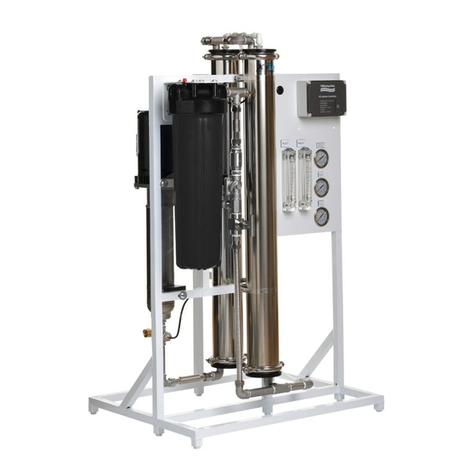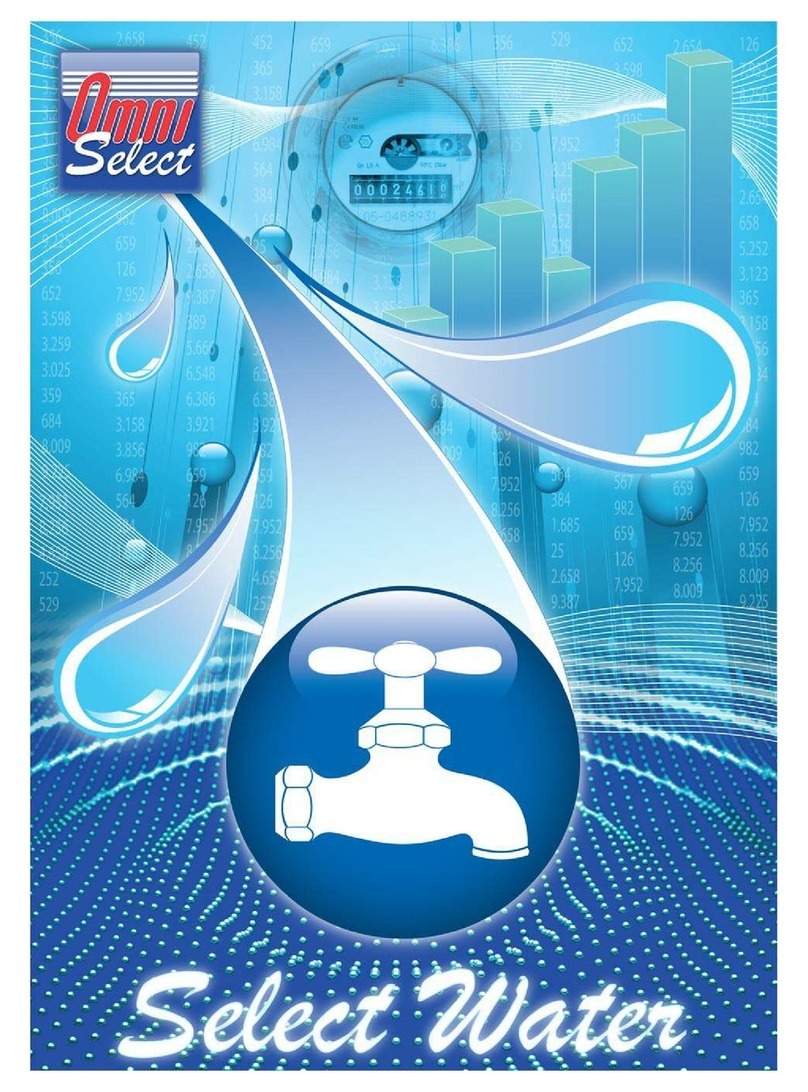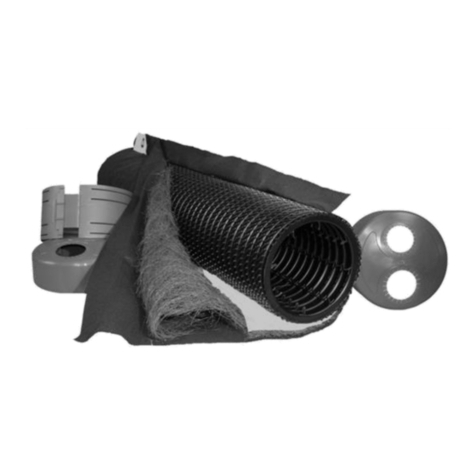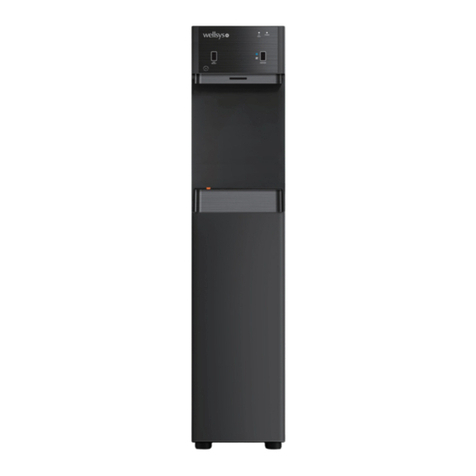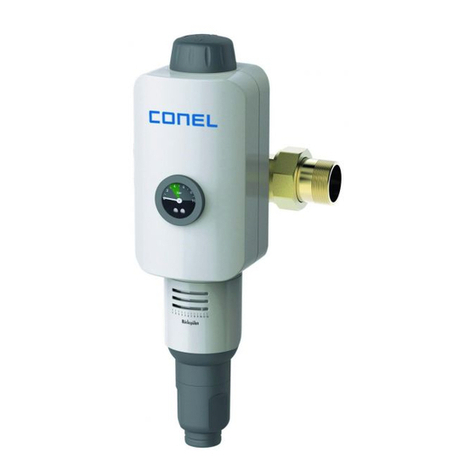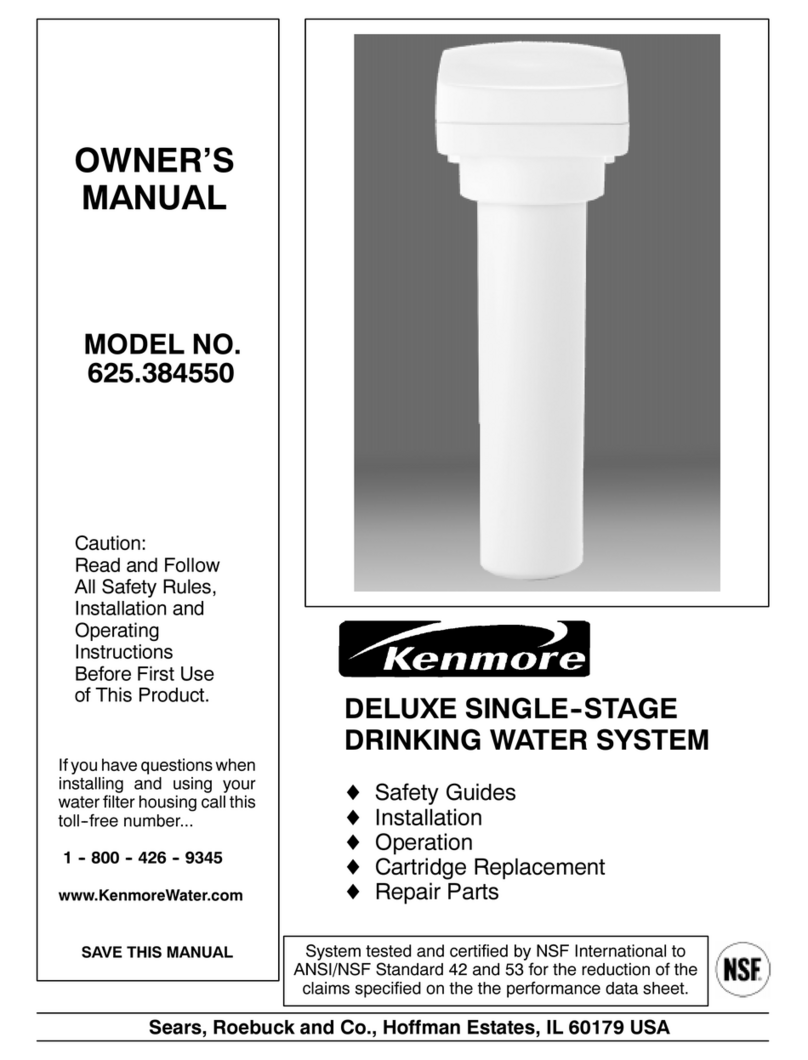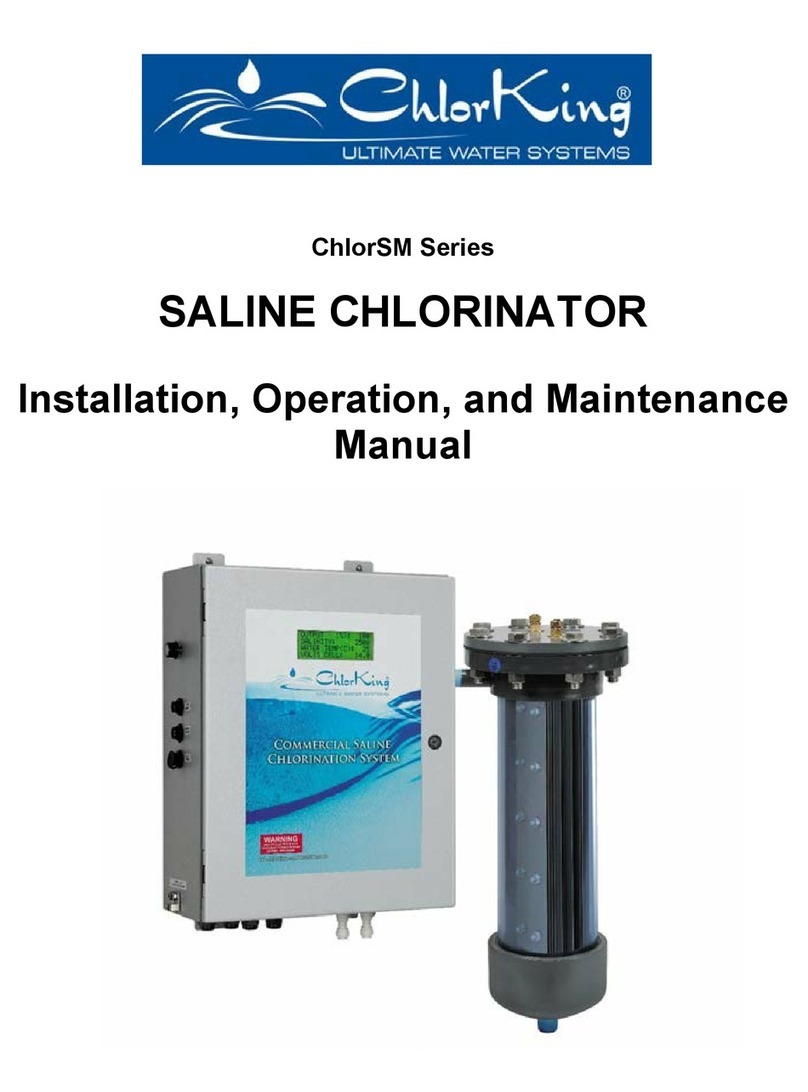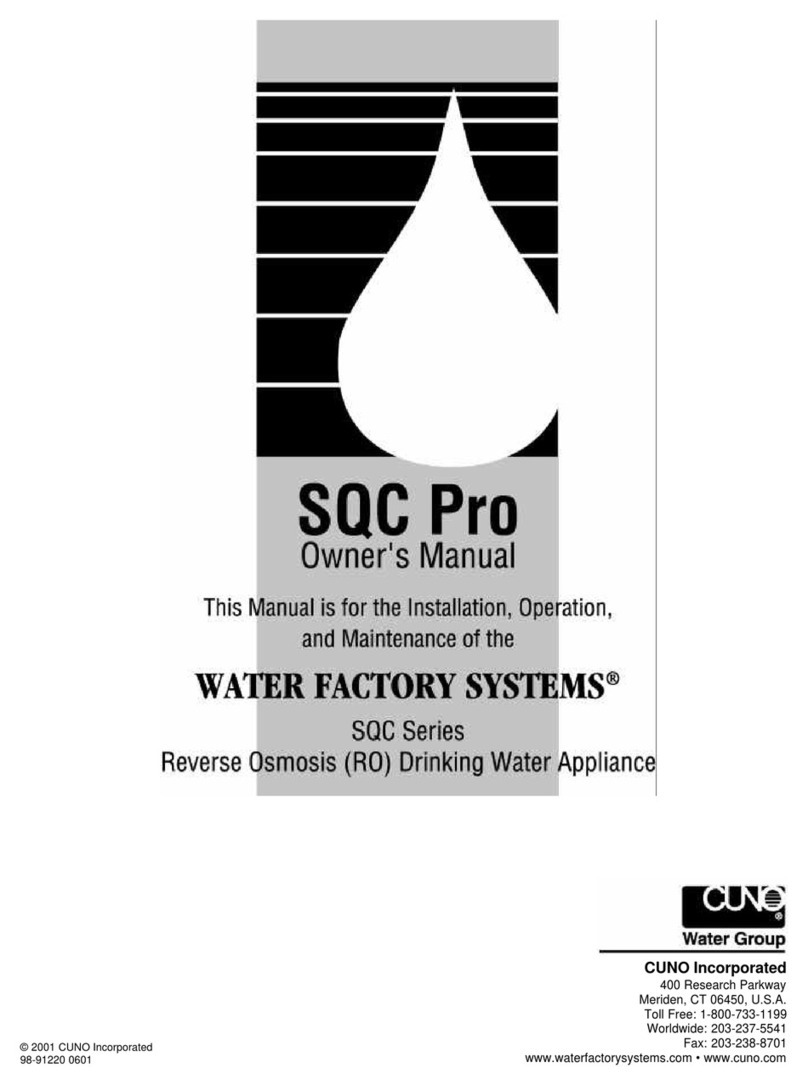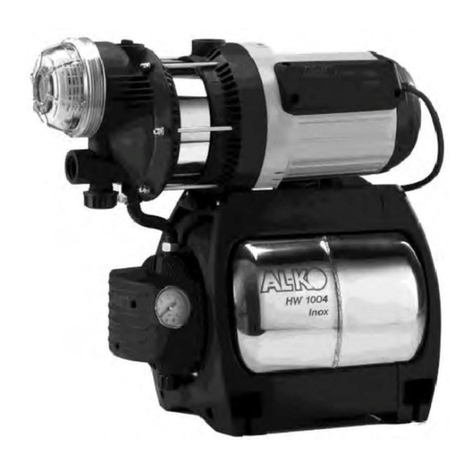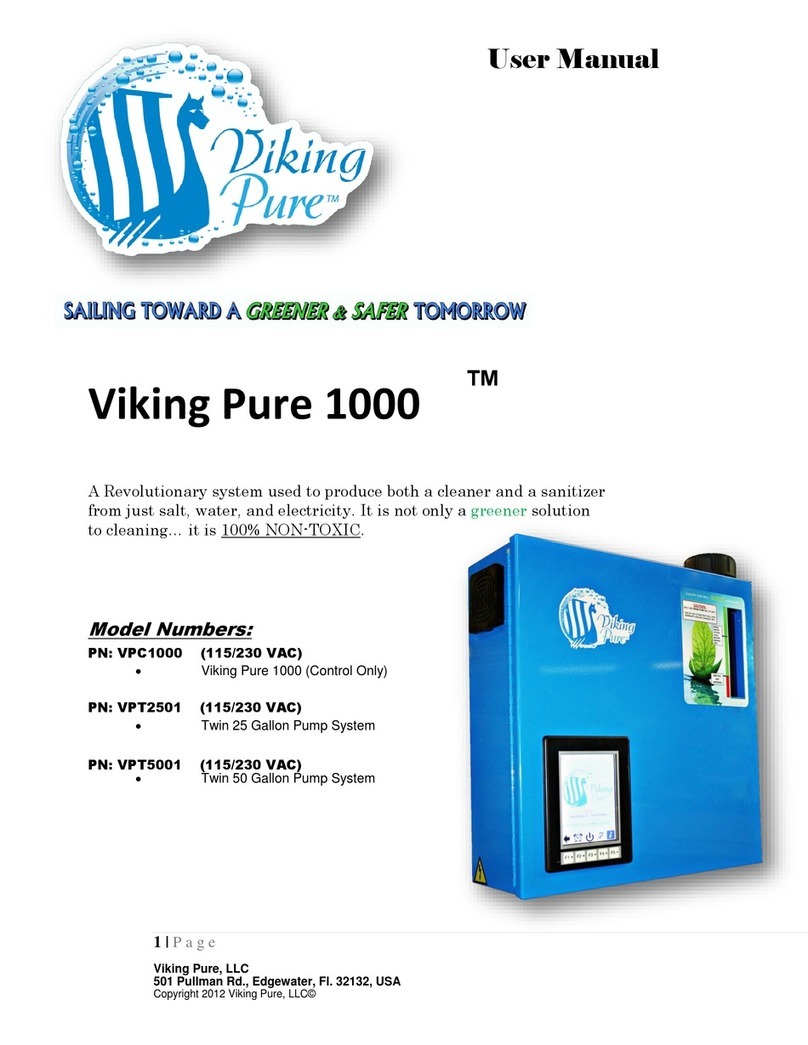Waterite VECTAMAXX RSR User manual

.
VECTAMAXX™ RSR
Advanced Reverse Osmosis System
OPERATOR’S MANUAL
FOR ALL VECTAMAXX™ RSR COMMERCIAL RO SYSTEMS
THIS MANUAL IS TO BE LEFT WITH THE OWNER OF THE EQUIPMENT FOR REFERENCE
PURPOSES AND TECHNICAL GUIDANCE. IT IS STRONGLY RECOMMENDED THAT
QUALIFIED DEALER SERVICE PERSONNEL BE CONTACTED IN THE EVENT OF AN
UNKNOWN INTERRUPTION OF SERVICE OR APPARENT PRODUCT MALFUNCTION. AN
ANNUAL PREVENTATIVE MAINTENANCE INSPECTION BY A WATER PROFESSIONAL IS
RECOMMENDED TO ENSURE TROUBLE-FREE AND CONTINUOUS OPERATION.
www.waterite.com
Waterite, Inc. ■ Winnipeg, MB Canada
R8

1
Congratulations!
You have purchased the finest commercial reverse osmosis water
system available. It will provide years of reliable service if properly
installed, operated and maintained. Please read this entire manual before
attempting installation and operation.
Before getting started, take the time to familiarize yourself with your new Waterite system by
reading some FAQs listed below. Call us or ask your dealer if you have any other questions
about your system’s operation.
Q: How does the VectaMaxx™ RSR Reverse Osmosis System differ from an ordinary water
filter?
Ordinary water filters use a screen to separate only particles of dirt and sediment from the raw water
source. Reverse osmosis employs a semi-permeable membrane that removes not only particles but
also a very high percentage of dissolved contaminants, molecule by molecule, from your raw water.
Your system will deliver pure, refined water consistently to the designated storage tank or water
distribution equipment.
Q: What is the membrane and how does it work?
The membrane element consists of several thin layers or sheets of film that are bonded together
and rolled in a spiral configuration around a plastic tube. As the raw water passes across the surface
of the membrane, only pure water molecules are allowed to pass through and collect in the tube,
while all other mineral and contaminant molecules are rejected and washed from the surface of the
membrane to the drain.
Q: What processes does the VectaMaxx™ RSR RO system use?
VectaMaxx™ RSR systems use two stages of treatment to produce high-purity product water. The
feed water first flows through a 5-micron polypropylene filter used to reduce suspended particles.
The second stage is the reverse osmosis membrane that separates most dissolved contaminants
from the water molecules. These standard processes will probably be augmented with additional
pre-treatment processes, depending on your raw water source.
Q: Will reverse osmosis remove sodium chloride and other salts from the water?
Yes. Reverse osmosis was originally developed to make drinking water from seawater. Your system
is equipped with a membrane that will be very effective in reducing sodium levels normally found in
ground water or softened water. VectaMaxx™ RSR systems are not designed for use on
seawater.
Q: Does reverse osmosis remove bacteria? Cryptosporidium? Viruses?
Reverse osmosis membranes will virtually eliminate most chemicals, bacteria, viruses and parasites
such as Cryptosporidium from the water. Where these conditions exist, pre-filters and other system
components located before the membrane will become contaminated from exposure to them. Cross
contamination of the entire system may occur when the membrane or filters are changed or
disturbed.
Section 1. Frequently Asked Questions

2
Q: What other contaminants does reverse osmosis remove?
The combined filtering and RO processes in your system will remove more than 98% of many
organic compounds, including THMs (chloroforms), DBCP, lindane, TCE (trichloroethylene), PCE
(tetrachloroethylene), carbon tetrachloride and chlorine. Very conservatively, a TFC membrane will
remove the following percentages of contaminants:
Barium
97%
Fluoride
90%
Radium
97%
Sulfates
97%
Bicarbonate
94%
Lead
97%
Selenium
97%
Total Dissolved
Solids
97%
Cadmium
97%
Magnesium
97%
Silicates
96%
PCBs
97%
Calcium
97%
Nickel
97%
Silver
85%
Insecticides
97%
Chromium
92%
Nitrates
80%
Sodium
92%
Herbicides
97%
Copper
97%
Potassium
92%
Strontium
97%
Detergents
97%
Q: Where is the system installed?
Each application will require access to the feed water source, electrical power and a drain for the
wastewater to be routed to. The system should be protected from the elements and at all times
protected from freezing. If the system is used to provide water to a critical piece of equipment, you
may consider protection from power surges and lightning strikes.
Q: Can the VectaMaxx™ RSR system be connected multiple appliances?
Yes. Many installations will involve providing water to multiple appliances or pieces of equipment
simultaneously. Make sure that the peak usage of water for the combined equipment does not
exceed the output of your RO system or its product water storage. See your dealer for advice and
parts.
Q: What factors affect the quantity and the quality of the water produced?
1.
Pressure: The greater the RO system pressure, the greater the water quantity that will be produced
by the membrane. Your VectaMaxx™ RSR unit has been equipped with ultra- low energy
membrane(s) that are designed to operate at a minimum system pressure of 100 psi. (7.0 kg/cm²)
and a maximum of 130 psi (9.0 kg/cm²) for models 1200 and 2400, do not attempt to operate your
system at pressures exceeding 150 psi, as damage to the membrane or premature fouling may
result.
2.
Temperature: Production increases with temperature, standard ratings established at 25°C. Never
operate the system from the hot water line or with water exceeding 40°C, as this will damage the
membrane and internal components.
3.
Membrane type: VectaMaxx™ RSR systems use premium quality TFC (Thin Film Composite)
membranes, specially chosen for general commercial applications. Please contact your dealer or
Waterite for information on special application or nanofiltration membranes.
4.
TDS: The higher the Total Dissolved Solids in the raw water, the lower the rate of output of product
water.
!
THIS REVERSE OSMOSIS WATER SYSTEM IS DESIGNED ONLY TO IMPROVE AESTHETIC
PROPERTIES AND IS NOT DESIGNED TO ACT
AS A PRIMARY BARRIER TO WATERBORNE
MICROBIOLOGICAL OR TOXIC CHEMICAL CONTAMINATION.
WHERE THESE CONDITIONS
MAY EXIST CONSULT A WATER PROFESSIONAL TO ENSURE SUFFICIENT RAW WATER
PRE-TREATMENT AND DISINFECTION.

3
Q: How much water does the VectaMaxx™ RSR system produce?
VectaMaxx™ RSR systems use membranes each nominally rated for 1200 or 2400GPD. Actual
output will be dependent upon the factors explained above. In optimal applications (low feed water
TDS, feed water =25°C, you may expect 700-1000 (RSR1200) and 1600-2100 (RSR 2400) USG from
each membrane to be available over 24 hours.
Q: Can the amount of total water produced be increased?
Once the system has been set for optimal operation, the overall water available for consumption
over a set period of time will be increased by increasing the storage capacity. This will increase the
time available for the unit to produce water in off-peak hours (instead of standing idle), and more
storage capacity to be available in peak hours when water usage may exceed production capacity,
for short intervals.
Q: What is the standard warranty with the VectaMaxx™ RSR system?
Every VectaMaxx™ RSR system comes with a standard one-year limited warranty on all parts and
shop repair labour, freight excluded. See section 5 in this manual for details on components with
limited warranty coverage.
Q: What is the maintenance schedule for the VectaMaxx™ RSR system?
A good rule of thumb is to replace the pre-filter every month in commercial applications. Consider
changing them biweekly when in continuous use or when used with untreated water sources.
Dependent upon feed water quality, your membrane(s) should have a life expectancy of 1-5 years.
More severe water conditions (iron, hardness) may shorten this significantly; soft water sources may
allow a membrane life of up to 8 years. See Section 5.
Q: When should the membrane(s) be cleaned or changed?
If you notice gradually decreasing production from your system, differing taste to your drinking water
or water analyses indicate a rising TDS, it probably means that your membrane(s) are deteriorating
and is losing effectiveness. You may purchase a pocket or full-featured TDS meter from your dealer
- this is the best way to gauge your RO’s operation.
Where the RO is used as a pre-treatment for a process requiring water to exact standards, you
should adopt a regular ongoing sampling and testing procedure to ensure compliance, as product
water will vary with the quality of the RO feed water.
Section 2. Designing your Installation
Your reverse osmosis system is designed to operate with feed water quality parameters that fall in
a specific range. The lifespan of the membranes and the ability of the system to produce water in
the required volume will depend largely on the feed water that is delivered to the system.
2.1. Start with a Thorough Water Analysis
Every successful installation begins with a full analysis of the raw water source. Testing should
measure the following:
•Total Hardness: This measures the calcium and magnesium hardness in the water. Hardness
in excess of 6 grains/gallon (103 mg/l) must be pre-treated by softening. Failure to do so will
cause premature failure of the membrane through lime scaling.
•Total Iron: Iron is another common membrane foulant. Found in most water supplies, it's
particularly prevalent in supplies drawn from wells. In its ferrous state (Fe+2), it's soluble.
However, when it's oxidized to its ferric state (Fe+3), it's insoluble and forms a

4
precipitate. Concentrations in excess of .05 ppm must be pre-treated with an iron remover
(concentrations > 2 ppm) or combination softener* (for iron concentrations < 2 ppm); otherwise
premature membrane and system equipment failure through iron deposit fouling will result.
•Manganese: Manganese is a commonly occurring mineral found in ground water. Manganese
will leave black, scaly deposits and will eventually foul membranes in concentrations greater than
.05 ppm. Manganese must be treated with a manganese greensand filter, regenerated with
potassium permanganate.
•Hydrogen Sulfide: Most commonly, hydrogen sulfide is known for its “rotten egg” odour. In
addition to having a objectionable odour, it is highly corrosive and will damage plumbing and
equipment. At lower concentrations (< 1 ppm) it can be removed with a Paterson Iron Remover
(air injection). At levels exceeding 1 ppm it will need to be treated with a manganese greensand
filter.
•Nitrates: The presence of nitrates in the water is usually an indicator for other problems with the
water source. Nitrates are a by-product of the decomposition of organic material that may include
sewage or run-off from septic systems. Surface runoff containing fertilizers will also be high in
nitrates. The source of the nitrates should be found and eliminated – feed water should be treated
with nitrate-selective ion exchange resins to reduce nitrates to < 5 mg/l.
•Tannins and Lignin: These are organic materials that are often contained in surface water and
shallow well water. Their origin is the natural decomposition of plant matter and tree barks,
leaving a brown colour ranging from a pale yellow to dark amber. Feed water tannins must be
pre-treated to levels < .5 mg/l to avoid membrane fouling. This is usually achieved through the
use of organic scavenging ion exchange resin (polystyrene or polyacrylic), regenerated with salt.
•Chlorine: Feed water should be free of chlorine (< .1 ppm), as TFC membranes are easily
damaged by chronic chlorine exposure. This is an important consideration when municipal water
is used as the feed water source. Pre-treatment by carbon filtration is very effective for chlorine
reduction – carbon eventually becomes exhausted and must be replaced to ensure continuous
filtration. If stabilized chlorine is present, size your carbon filter 2 to 3 times larger than for un-
stabilized chlorine to ensure removal. Consider installing a post-carbon filter test port for ease of
sampling.
•Organic and Microbiological Activity: Raw water sources, particularly surface water, often
contain algae and naturally occurring bacteria. Ground water may contain sulphur or iron
reducing bacteria or may be contaminated with other more dangerous strains of coliforms or E.
coli. These must be treated to avoid contamination or fouling of the pre- treatment systems or
membrane element(s).
•pH: Most membrane manufacturers recommend a pH range between 3.0 and 11.0 for the
membrane element. We recommend that the system operate at between 5.5 and 9.5, to minimize
the effects of extremely acidic or scale-forming water at either ends of the range. Extremes in
pH will be harder on your system, either causing premature.
* When softeners are used for iron reduction, be sure to fit your softener with a resin bed cleaner to assist in
the flushing of iron deposits from the resin bed during backwashing and regeneration.

5
corrosion on metallic parts or scaling internal components upstream from the membrane, and
likely the membrane itself. Keep in mind that reverse osmosis lowers the pH of the feed water,
by up to 1.0, depending on the water chemistry. This will be a consideration for the end use of
product water and for the vessels and plumbing system that will be used to store and control it.
•Turbidity: This is the term to describe suspended particulate in the raw water. Turbidity is treated
by the sediment cartridges that your RO system has been equipped with. Reduction of turbidity
is necessary to avoid fouling your membrane and damaging your drive pump. Make sure that
your pre-filters are changed regularly and that quality Excelpure 5-micron cartridges are used as
replacements. The SDI (silt density index) on feed water reaching the membrane must be kept
< 5 to assure long membrane life.
2.2. Plan Your Pre-treatment Strategy
Pre-treating feed water can lengthen the life of membrane elements, improve the quality of the water
produced and reduce the amount of maintenance and cleaning a system requires.
The importance of feed water conditions is evident when you examine how crossflow membranes
work. In simple terms, a crossflow filtration system separates an influent stream into two effluent
streams - the permeate and the concentrate. The permeate is the portion of the fluid that has passed
through the semi-permeable membrane. The concentrate stream, on the other hand, contains
constituents that have been rejected by the membrane.
An inherent advantage of crossflow filtration is its ability to continuously operate in a self-cleaning
mode. It's self-cleaning because suspended solids and rejected solutes are constantly swept away
from the membrane surface. Membrane fouling occurs when materials from the feed stream collect
on or near the membrane surface and restrict water permeation. Fouling may occur as layers of
deposition on the surface of the membrane (cake fouling), a hardened layer on the membrane
surface (scale), particle insertion into the pore channel or entrance (pore blockage), or chemical
attachment of particles to the membrane (adsorption).
You will note that many of the prescribed treatments for various raw water conditions will be effective
in treating more than one problem. Where multiple pre-treatment requirements are necessary,
consult with a water treatment professional to design a pre-treatment system that meets the
necessary needs most economically.
Use the pre-treatment summary below to prescribe the necessary pre-treatment where your water
analysis indicates parameters outside of the recommended range:

6
Pre-Treatment Summary Chart
Recommended
Feed Water Range
Potential
Effect Pre-Treatment Solution Waterite
Models
TDS
< 2000 ppm
Reduced production rate
Increased salt passage
Contact Waterite/ Replace
water source RSL HP
T. Hardness
< 6 grains/gal
(103 mg/l)
Scaling of membrane surface
Reduced production rate Automatic Softener
Fusion² series
Gem series
Total Iron
< .05 ppm
Reduced production rate
Fouling of membrane surface
Iron deposits in equipment
Iron Remover (> 5 ppm)
Softener (levels < 5 ppm) FOB series
Tannins
< .5 ppm
Reduced production rate
Fouling of membrane surface
Softener with organic
scavenger resin Gem series
Chlorine
< .1 ppm
Permanent membrane damage
Increased salt passage Carbon Filter
Fusion² CF
series
pH
5.5 – 9.5
Internal corrosion
Lime scaling in equipment
Plumbing damage
Replace water source
Adjust pH
Call your
dealer
Organic or
Microbiological
Activity
0
Reduced production rate
Fouling of membrane surface
Sliming of pre-treatment equipment,
odour
UV Disinfection followed by 1-
micron filtration
Well chlorination
Excelight UV
Excelpure
WellPro
Manganese
<. 05 ppm
Reduced production rate
Fouling of membrane surface Manganese Greensand Filter Greensand
Catalox
Hydrogen
Sulphide
0
“Rotten egg” odour
Internal corrosion
Iron Remover (<1 ppm)
Manganese Greensand Filter
(> 1 ppm)
Greensand
Catalox
Turbidity
SDI < 5.0
Reduced production rate
Plugging of membrane
Rotary vane pump damage
Multimedia Filter
Pre-treatment cartridges
Nextsand
Excelpure
!
TEST THAT THE PRE-TREATMENT SYSTEM IS DELIVERING RO FEED WATER TO
NECESSARY SPECIFICATIONS BEFORE PLUMBING THE RO SYSTEM ONLINE.

7
2.3. Plan Your Water System
1.
Using a Pressure Storage Tank and Pressure Switch
Your RO system will produce permeate (product water) at a pressure capable of pressurizing a
bladder tank, though tank recovery time will be limited by the production rate of the membrane(s).
Rates of water production for Vectapure™ RSR systems are, at maximum (feed water @<1000
TDS):
RSR1200 0.8 USG/min. (3.0 liters/min.)
RSR2400 1.6 USG/min. (6.0 liters/min.)
For many systems, this rate of recovery will be insufficient in periods of peak usage. It will be
necessary for you to provide product water storage in a non-pressurized tank from which you may
re-pressurize the water for delivery to your appliances or plumbing system.
If a pressure tank and pressure switch is used, be sure that the pressure switch is capable of carrying
the full load amperage of the pump motor. For reference, the motor full load amperages are:
120VAC
RSR1200 15 A
RSR2400 15 A
Consult your electrician to determine the proper sized breaker for your installation. Other motor
voltages are available as a factory option. Consult with your dealer for availability and pricing.
!
ALWAYS ALLOW A NEW SOFTENER INSTALLED TO PRE-TREAT AN RO SYSTEM TO START
ON THE BACKWASH/REGENERATION/RINSE CYCLE. OPERATE THE SOFTENER OFF-LINE
UNTIL WATER RUNS CLEA
R BEFORE USING IT TO PROVIDE RO FEED WATER. THIS
PROCEDURE ALSO APPLIES TO NEW RESIN BED INSTALLATIONS. COLOUR THROW
FROM NEW RESIN BEDS MAY DAMAGE OR FOUL RO MEMBRANES.
!
WATERITE DOES NOT RECOMMEND THE USE OF A GRANULAR CARBON CARTRIDGE IN
THE PRE-TREATMENT FILTER HOUSINGS SUPPLIED, FOR THE PRIMARY REDUCTION OF
CHLORINE. IT WILL REQUIRE REPLACEMENT TOO OFTEN, LIMIT FLOW RATES AND
LIKELY LEAD TO CHLORINE BREAKTHROUGH TO THE MEMBRANE ELEMENT. WE
RECOMMEND THAT THIS HOUSING BE RESERVED FOR 5-MICRON OR 1-MICRON
SEDIMENT CARTRIDGES, FOR THE REDUCTION OF SUSPENDED PARTICULATE.
!
IF THE SYSTEM IS CONNECTED DIRECTLY TO A PRESSURE TANK, MAKE SURE THAT A
CHECK VALVE IS INSTALLED ON THE PRODUCT WATER LINE BETWEEN THE MACHINE
OUTLET AND THE PLUMBING SYSTEM PRESSURE
SWITCH, TO ELIMINATE
BACKPRESSURE ON THE MEMBRANE(S). FAILURE TO DO SO WILL CAUSE PERMANENT
DAMAGE TO THE RO MEMBRANE(S).

8
The pressure switch will be used to turn off the RO unit at the cut-off pressure and turn it on at the
cut-in pressure, in the same way one is used to control a water well pump. Set the pressure switch
to a maximum shut-off pressure of 60 psi.
The pressure switch must be wired to break the current on the power line between the power source
and the RO unit’s switchbox. Do not break the current at the pump motor, as this will cause the inlet
solenoid to remain activated and open when the machine is shut down. Waterite offers an optional
factory-installed permeate high pressure cut-off (Waterite P/N RSRPSO) for this application.
2.
Using an Atmospheric Pressure (non-pressurized) Storage Tank and Float Switch
Your VectaMaxx™ RSR RO may be wired to a float control shut-off switch that shuts the system
down when a non-pressurized storage tank is filled. Make sure that the tank size is selected to
provide adequate water storage for your peak demand period. Keep in mind that atmospheric water
storage vessels are subject to contamination by airborne bacteria – they should include a lid, be
sanitized before use and periodically disinfected. RO product water will have no chlorine residual
and will be subject to contamination at all stages in the plumbing system. Consider UV disinfection
as an inline option for all water being pumped from the storage tank into the plumbing system. An
overflow bulkhead drain fitting should always be installed in the tank and connected to a floor drain
to protect from a failed level switch.
If the inlet bulkhead fitting to the non-pressurized tank is below the maximum water level in the tank,
make sure that a check valve is installed in the product water line between the RO unit’s outlet and
the tank inlet. This will ensure that backpressure from the tank will not damage the membrane(s).
To eliminate this problem, install the bulkhead fitting above the level switch.
Consult your Waterite Commercial RO Systems Price List for information and availability on a
wide variety of water system components including storage tanks, repressurization pumps,
bulkheads, tube, pipe, pressure switches, fittings, UV disinfection systems and float valves.
Section 3. Installation
Your system includes:
•The main RO/filter assembly frame with one assembled pre-filter, booster pump, membrane
housing(s), flow controls, pressure gauges, flow meters and RO controller.
•One membrane (in a sealed plastic bag and one 5-micron polypropylene sediment cartridge;
•One sediment filter housing wrench;
•One Owner’s package including owner’s manual and warranty certificate.
3.1. Selecting the System Location
1.
The filter housing will need periodic maintenance - easy access must be maintained. Do not
install in a location with high humidity, direct sun or a direct source of heat. Typically, a
commercial mechanical room is ideal. Never expose the RO unit to freezing temperatures.
2.
Use the threaded feet at the base of the RO stand to level the unit.
3.
The unit will need to be installed in a location that has ready access to 120V power, the feed
water line and near a drain capable of handling the waste flow from the machine.

9
Pressure Gauges RO Controller
TDS monitor (optional)
Low pressure switch Membrane housing
Waste and permeate Inlet solenoid
flow meters
Pre-filter housing Auto flush solenoid
(optional)
Drive pump
Levelling feet
Figure 1.
Drain line flow control
(DLFC)
A Note on Fittings
Your RO system has been equipped with quality compression and push on fittings throughout. Any
compression fittings should be hand-tightened and then tightened ¼ turn further with a wrench.
Always use the ferrule and tube stiffener provided for each joint. Check that all fittings are snug, as
they may have loosened in transit.
Completing and securing a push-on connection is simple. First, the tubing should be cut square and
any burrs or rough edges removed. Insert the tube firmly and push until the tube end contacts the
stop. Gently tug the tube backwards to assure a secure connection. To disconnect, pull the tube
while pushing in the collet ring. Fittings may be reconnected over and over again, if necessary. See
figure 2. below.
Figure 2.
3.2. Install the Feed Water Supply Connection
1.
Inspect the cold water supply line and the condition of the pipe. Ensure that the supply pipe
is in good overall condition and is capable of delivering the system’s necessary feed water
flow rate. See Section 8 for specified feed water flow rate requirements.
2.
Turn the water supply line to your plumbing OFF.

10
3.
Plumb a connection from the COLD water supply line, ensuring that the feed line is at least
1/2” in diameter. Install a shut off valve on the connection, so that the RO system can by
isolated from the main water supply. Note that the inlet connection to your RO system is 1/2”.
We recommend that you also install a pipe union near the RO to allow easy disconnection
should it be required for maintenance.
4.
Make sure the feed water source is a reliable one and will constantly deliver feed water
between 40 psi and 60 psi maximum. Your RO system has been equipped with an
emergency low pressure shut-off, in the event that the line pressure to your RO inlet falls
below 20 psi. This will keep the drive pump from running dry and damage occurring to its
internal components.
3.3. Installing the Drain Line
1.
A 3/8” poly tube (minimum) should be used for the drain line. For systems equipped with
the fast flush option a 1/2” drain line should be installed. Position the drain line over the
drain and secure it in place. Do not elevate the drain line over 10 feet above the unit. If
connection to a sewer line is necessary, check the local code or a plumbing professional for
guidance and the required parts. Usually a trap with a 2” air gap will suffice.
2.
DO NOT use a residential septic field for receiving the RO waste from VectaMaxx™ RSR
systems. If used to 24-hour capacity, these systems (depending on the model and settings)
will produce between 763 to 3456 USG (2880 to 12960 liters) per day of wastewater and will
waterlog septic beds.
The amount of waste produced by your system is determined by a fixed, drain line flow control
(DLFC) that has been factory-installed. Do not attempt to restrict or alter the rate of waste
low as this will cause premature membrane failure or loss of permeate production.
3.4. Installing the Filter Cartridge and Membrane (s)
1.
Remove the filter housing by turning counter-clockwise with the housing wrench supplied.
Remove all protective wrapping from the 5-micron filter cartridge. Insert the 5-micron white
sediment filter in the housing and reassemble. The housing is seated with o-rings – DO NOT
OVERTIGHTEN – 1/4 turn or less after hand tight is usually sufficient.
Skip (2.) below if the factory has pre-loaded your membrane elements.
2.
Remove the wrapping from the membrane element(s). Lightly lubricate the membrane brine
seal and all o-rings located in the membrane housing caps with a good quality, silicone o-
ring lubricant (do not use petroleum-based lubricants). Disconnect the connections on the
membrane housing’s top end cap. Remove the end cap from the membrane housing by
loosening the band clamp nuts and bolts. The membrane housing is mounted vertically on
the system’s stand. See Figure 1. Insert the membrane element into the housing, so that the
brine seal of the membrane will seat at the inlet side of the membrane housing (this is
indicated by the direction of flow label on the housing). See
!
ALWAYS MAINTAIN OR INSTALL A 2” AIR GAP ON ALL DRAIN LINES TO
PREVENT SEWAGE BACK-SIPHONAGE.

11
Dir
Figure 3. Gently push and slowly twist until the membrane product adapter seats snugly inside
the housing cap still in place at the bottom of the housing. Re-install the disassembled housing
cap - be sure that o-rings do not roll out of their grooves, get pinched or cut. Re-install the
band clamp snugly and reconnect the connections to the cap.
End cap
O-rings
Groove clamp
Product
adapter
Membrane cage Direction of flow label
Membrane housing body
Brine seal
Figure 3. (Stainless membrane housing)
3.
To remove the membrane from the housing, remove the top housing end cap and gently pull the
membrane out of the housing body. You may need to lightly grip the membrane cage with needle-
nose pliers to free it from the housing, after extended use. With each disassembly, always check
the end cap o-rings and the membrane brine seal to make sure that they are in good condition
and are secure in their seating grooves. While the housing is disassembled, clean all components
thoroughly to remove any debris or scaling. When re-assembling, make sure that that membrane
element is installed with the brine seal facing in the same direction as was previously. See
direction of flow label on each membrane housing.
3.5. Complete the Electrical Connection
1.
VectaMaxx RSR systems operate using a 120V 20A service and a grounded receptacle. Assure
that the power source is rated to the necessary amperage (see page 8) and that the connection
meets the local electrical code. See the electrical diagram on page 20.
GROUNDING INSTRUCTIONS – This appliance must be grounded. In the event of a malfunction or
breakdown, grounding will reduce the risk of electric shock by providing a path of least resistance for
electric current. This appliance is equipped with a cord having an appliance – grounding conductor
and a grounding plug. The plug must be plugged into an appropriate outlet that is installed and
grounded in accordance with all local codes and ordinances.
WARNING – Improper connection of the appliance – grounding conductor can result in a risk of
electric shock. Check with a qualified electrician or service representative if you are in doubt whether
the appliance is properly grounded. Do not modify the plug provided with the appliance; if it will not fit
the outlet, have a proper outlet installed by a qualified technician.
!
DO NOT START THE SYSTEM UNTIL THE NEXT STEP IS COMPLETE.

12
Section 4: System Set-Up
Set-up of your RO system will be dependent upon the TDS of your feed water. Make sure that you
specify the TDS of your feed water at the time the unit is ordered. The system has been shipped
with a waste control orifice that will be intended for feed water of less than TDS of 1000.
This orifice has been selected to operate at the correct waste flow rate for your system without the
need for a waste throttling valve. For systems configured for <1000 TDS, the recovery rate will be a
maximum of 60%. For systems configured for >1000 -1500 TDS, the recovery rate will be a maximum
of 35%.
4.1. RO Controller Set-Up
1. System Controller Specifications
Inputs
Tank level switch
(1) Normally-Closed. RO runs on switch closure.
Inlet pressure switch
Normally-Open. Switch opens on low pressure.
Pretreat lockout switch Normally-Open. Pretreat lockout active with switch closure.
NOTE: All switch inputs are dry contacts. Voltage applied to the
switch inputs will damage the controller
Controller Power 120/240 VAC, 60/50Hz (Range: 96-264 VAC)
The switching power supply automatically adjusts to supply voltage.
Voltage applied to the input is the same voltage the motor and
valves will operate on.
Relay Output Ratings
Feed Solenoid
12A. Output Voltage is the same as motor/supply voltage.
Flush Solenoid 12A. Output Voltage is the same as motor/supply voltage.
The solenoid relay ratings above reflect the capacity of the relays only.
The current capacity of reach circuit is 2A.
Motor 1.0 HP @ 120V,
2.0 HP @ 240V.
Circuit Protection
Controller Power Fuse F1 5x20mm 1/4(0.25) Amp Little Fuse 0218.250MXP
Branch circuit protection, motor and valve protection must be provided
externally.
Other
Dimensions
7” tall, 5” wide, 2.375” deep. Nema 4X Polycarbonate Enclosure.
Weight
1.1 lb.
Environment
0-50˚C, 10-90%RH (non-condensing)

13
2. RO Controller Interface
•DIP Switch Settings
RO Program Settings
Switch 1
Switch 2
Program
ON
OFF
1
OFF
OFF
2
Standby/ON Switch
Capacitive touch switch. Tank Full LED turns Red to
confirm button contact. To use switch to switch states,
hold for 1-2 seconds.

14
3. RO Controller Programming
The controller has 2 separate user-selectable sets of settings for configuring the RO. The factory
default settings are shown below. The settings are identical except for variations in the flush behavior.
Program 1, No Flush (Standard)
Program 2, High Pressure Flush (Optional)
See “DIP Switch Settings” for instructions on how to select these programs
Parameter
Value
Program 1
Program 2
Tank Level Switch delay (actuation and de-actuation)
Seconds
2
2
Pressure Switch delay (actuation and de-actuation)
Seconds
2
2
Pretreat Switch delay (actuation and de-actuation)
Seconds
2
2
Pump start delay
Seconds
10
10
Inlet Solenoid stop delay
Seconds
1
1
Pump start retry interval (restart delay after LP fault)
Seconds
60
60
Low pressure fault shutdown, # of faults
faults
5
5
Low pressure fault shutdown, time period to count faults
Minutes
10
10
Low pressure fault shutdown, reset after shutdown
Minutes
60
60
Low pressure timeout fault
Seconds
60
60
Flush Behavior No Flush High
Pressure
Startup Flush: Minutes from last flush
Minutes
0
0
Startup Flush: Duration
Seconds
0
0
Periodic Flush: Interval
Minutes
0
60
Periodic Flush: Duration
Seconds
0
60
Shutdown Flush: Time from last flush
Minutes
0
10
Shutdown Flush: Minimum operation
Minutes
0
30
Shutdown Flush: Duration
Seconds
0
60
Timed Manual Run
Minutes
5
5
Timed Manual Flush
Minutes
0
5
4.2 Starting Up and Flushing the System
1.0 Turn on the feed water valve to the system and check all connections for leaks. Do not proceed
further until any leaks are fixed. Water will flow to the pre-treatment housings but will not pass the
inlet solenoid (see Figure 4.) until the system has been started. The available line pressure should
now register on the line pressure gauge. Purge any air from the pre-filter housing by pressing the
Red valve on top of the housing
2.0 Open the recirculation valve to the fully open position.
3.0 The system pump must be initially primed and at any time that the system has been drained, prior
to start-up. THE PUMP MUST NOT BE RUN DRY OR DAMAGE WILL RESULT. Please refer to
the pump manual (included) for priming instructions.

15
4.0 Once the pump is primed, connect the power plug to the electrical source. The system will start in
the ON position. Let the system operate for about 5 minutes with the valve fully open. The system
is now flushing and clearing any dust or debris from the lines. There should be little or no water
production from the machine during this process. All water, including permeate, should be
discarded and sent to drain.
Low pressure shut off switch
Inlet solenoid
Fast flush solenoid (optional)
Pump priming plug
Recirculation valve
Pump drain plug
Figure 4.
5.0 The system is designed to normally operate at 130 psi. At this pressure, the proper
waste/production ratio is established. Next, begin to close the recirculation valve slowly until the
operating pressure gauge registers 130 psi (9.1 bar). DO NOT ALLOW THE SYSTEM TO
OPERATE IN EXCESS OF 150 PSI AS MEMBRANE AND SYSTEM DAMAGE MAY RESULT.
You may wish to lock the valve in the proper position by removing the handle to discourage
tampering. Your system is now set up to operate at its design settings.
6.0 A Note on Recovery Rates
Your VectaMaxx™ RSR is designed to operate at a recovery rate (percentage of product water to
total water used) at maximum of 60% for feed water of <1000 TDS and 35-40% for feed water with
TDS ranging from 1000 to 1500. DO NOT ATTEMPT TO OPERATE THE SYSTEM AT HIGHER
RECOVERY RATES, AS THIS WILL CAUSE PREMATURE MEMBRANE FAILURE OR
INTERNAL SCALING AND EQUIPMENT FAILURE.
!
YOUR MEMBRANES MAY HAVE BEEN SHIPPED WITH AN ANTI-BACTERIAL
PRESERVATIVE. OPERATE THE SYSTEM FOR 1 HOUR AT DESIGN SETTINGS BEFORE
BRINGING THE SYSTEM ONLINE TO ASSURE MEMBRANE HAS BEEN COMPLETELY
FLUSHED. DO NOT USE WATER PRODUCED DURING THIS RUN-IN PERIOD.

16
You may wish to operate your system at lower recovery rates where your dealer has identified water
conditions that may stress your membrane or where recommended pre-treatment feed water conditions
are not met. You may do so, though this must be accomplished by a combination of increasing the flow
of concentrate to waste and reducing the recirculation valve flow. This, done in balance, will maintain
the overall system pressure at previously stated normal operating pressures.
Where your system is equipped with flow meters, simply open the concentrate valve to the desired flow
rate and close the recirculation valve until the pressure registers normal operating pressure. Using the
formula:
% Recovery Rate = Flow rate of Permeate (Product Flow)
Flow rate of Permeate + Flow rate of Waste
adjust the valves until the appropriate balance is met. Once the new balance has been established
at normal operating pressure, you may wish to lock the valves in position by removing the handles
by loosening the setscrews located on the valve handle.
Section 5: System Maintenance
Changing Pre-filter Cartridges
The pre-filter cartridge should be changed, as a rule of thumb, every month, biweekly in heavy use
applications. It is critical that this be done to ensure that pre-treatment cartridge allow necessary flow
and that suspended particulate is removed from the feed water.
To change the cartridge, turn off the system’s power and as a safety precaution, close the water
supply to the unit. Repeat Step 7 (1) from the installation instructions above. Thoroughly flush and
clean the filter housings while they are disassembled. Always use Waterite factory cartridges as
replacements.
Monitoring your System Performance
Your system will be operating at its peak performance after about 24 hours of operation. You should
develop a daily log to track line pressure, system pressure, feed water TDS, permeate TDS, permeate
flow rate and waste flow rate. This will allow you to see any developing performance trends or alert
you to system changes that will require you to intervene. It will also be helpful for your dealer or
Waterite technical personnel to have this information available to help troubleshoot your system,
should it become necessary. The table provided in the last few pages of this manual (Section 9) will
help you get started.
Fast Flushing your VectaMaxx™ RSL
Consider ordering your system with the automatic auto flush option, which can be set for a
periodic fast flush automatically. (Waterite P/N RSRAF) This option should be considered for any
application with over 4 grains/gallon of hardness, any measurable iron in the raw water source or raw
water TDS that exceeds 500ppm. This will substantially increase the life of the membrane element.

17
Cleaning your Membrane Element
As your membrane begins to age, it will gradually lose some output performance. This is normal and
may result in an overall permeate flow loss of 5% after about 1 year. Your membrane(s) may
eventually begin to lose production due to fouling or scaling in its interior. Symptoms of this may be
continuously falling production rates or elevated TDS levels in the product water. Do not attempt to
operate the system above specified pressures to compensate for output loss.
Total Dissolved Solids may be measured by a professional or by use of a simple hand-held TDS
monitor. These are available from your dealer.
Pocket TDS meter
(Waterite P/N HMTDS3)
The membrane element life will range from 1 to 5 years, depending on the quality of the raw water.
See S.3 (7)(2) for membrane removal and installation instructions.
If you suspect your membrane element requires cleaning or replacement, contact Waterite or your
dealer. Do not attempt to clean the element yourself, as it requires specialized chemicals,
procedures and equipment. If you remove your membrane from the housing, make sure that you
keep it wet, preferably in a sealed and sterile plastic sleeve.
It is a good idea to always keep an extra membrane on hand to avoid system downtime when
replacement is necessary. Never allow a membrane to dry out (if wet variety) or freeze while
in storage.
A Word on your Warranty
Keep your bill of sale and your warranty certificate, included in this kit. This is needed to claim any
parts or repair service during the warranty period. Read the document completely for warranty claim
instructions.
Your VectaMaxx™ RSR system comes with a limited one-year warranty covering materials and
workmanship for one year from date of installation, subject to user’s compliance with these
maintenance and operating instructions. Membranes are excluded by the warranty and the seller’s
responsibility is limited to any warranty carried by the manufacturer. It is the purchaser’s
responsibility to immediately notify Waterite in the event that defects are detected. Seller shall not
be liable for any special, incidental or consequential damages and will at its option repair or replace
any defective components. Warranty excludes O-rings, membranes, pre-filter cartridges, freight
charges, labour to remove or re-install equipment, use with feed water in excess of 1500 TDS, use
of feed water that does not meet recommended conditions and with system alterations made, without
a written approval from Waterite.

18
Section 6: Trouble Shooting Guide
Problem Possible Cause Solution
Low or Declining Water supply valve closed. Open valve.
Permeate Production Crimped poly product line Repair or replace tube
Raw water TDS too high Consult dealer – may
need pre-treatment.
Membranes fouled. Clean or replace
membrane.
Fast flush system.
Membrane installed upside down. Install element correctly
Low operating pressure. See “Low System
Pressure”.
Brine seal rolled out of groove. Re-install membrane
using lubricant. Check
brine seal for damage.
Feed water content has changed. Review pre-treatment.
Pre-treatment cartridges plugged. Replace cartridges.
Leaking Joints Fittings not seated. Disconnect fitting
and
reseat tube.
Filter housing leaking. Tighten with housing
wrench.
Inspect o-rings for cuts or
crimps.
Low System Pressure Clogged pre-filter or fouled pre-treatment. Replace pre-filter
cartridges.
Low feed water pressure. Check feed water
source
for restrictions.
Inlet solenoid closed. Check solenoid circuit-
replace if necessary.
Drive pump malfunctioning. Call dealer.
Malfunctioning pressure gauge. Replace gauge.
High System Pressure Plugged or restricted concentrate. Clean or replace valves.
and/or recirculation valves.
Crimped product line. Repair or replace tube.
Malfunctioning pressure gauge. Replace gauge.
Permeate TDS Rising Scaled, perforated or fouled membrane(s). Clean or replace
membranes.
Fast flush membrane.
Pre-treatment system failure. Check feed water
quality.
O-rings on product adapters Check and replace
cut or damaged. damaged o-rings.

19
Section 7: Common Replacement Parts
Part Description
Part Number
Excelpure 10” BB 5 Micron PP Spun Cartridge
PP10B05
Excelpure 10” BB 1 Micron PP Spun Cartridge
PP10B01
1/2” Inlet Solenoid
ROSD110
Low Pressure Cut-off Switch
FRG22
1½” Pressure Gauge, 0-200 psi
AG06
Pre-filter Housing Wrench
HAN13W
Recirculation Valve, ½”, SS
IVISBFF8
Membrane Product Adapter O-ring
N70210
Membrane Housing End Cap O-ring
N70342
Pre-Filter Housing O-ring
RKE0013HLB
Black Max 4021 Membrane, TFC, XLP
BME4021SL
Black Max 4040 Membrane, TFC, XLP
BME4040SXL
Orifice Plate Flow Control 0.37 gpm RSR 1200
5865041
Orifice Plate Flow Control 0.5 gpm RSR 2400
5865051
Section 8: Feed Water Flow Requirements
RSR1200:
3.2 USGPM minimum
includes 20% safety factor
RSR2400:
6.4 USGPM minimum
on 1000 TDS feed water.
Feed water must be available at a minimum of 40 psi and a maximum of 60 psi at the specified
flow rate.
When auto flush is active, unit will require 10 gpm at a minimum feed pressure of 30 psi.
Table of contents
Other Waterite Water System manuals
Popular Water System manuals by other brands
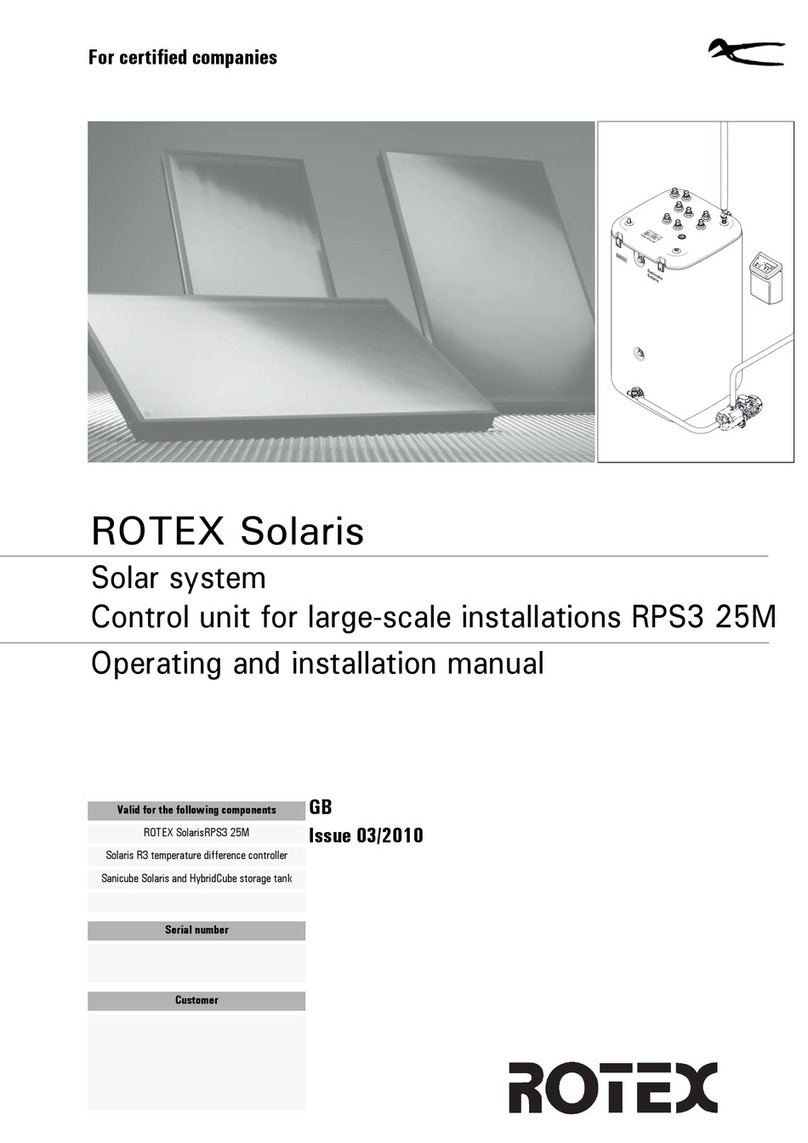
Rotex
Rotex Solaris RPS3 25M OPERATING AND INSTALLATION Manual
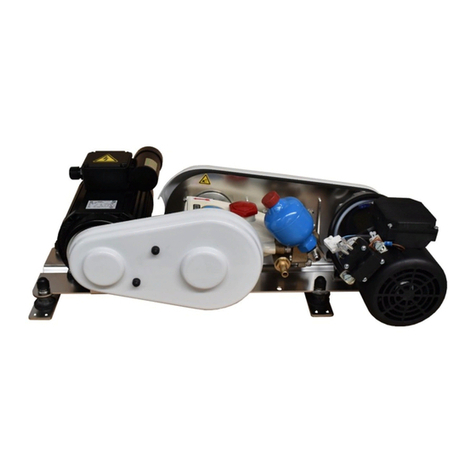
DESSALATOR
DESSALATOR DUO D100 Assembly and user's manual

Judo
Judo JUKOMAT-LONGLIFE-AT Installation and operating instructions
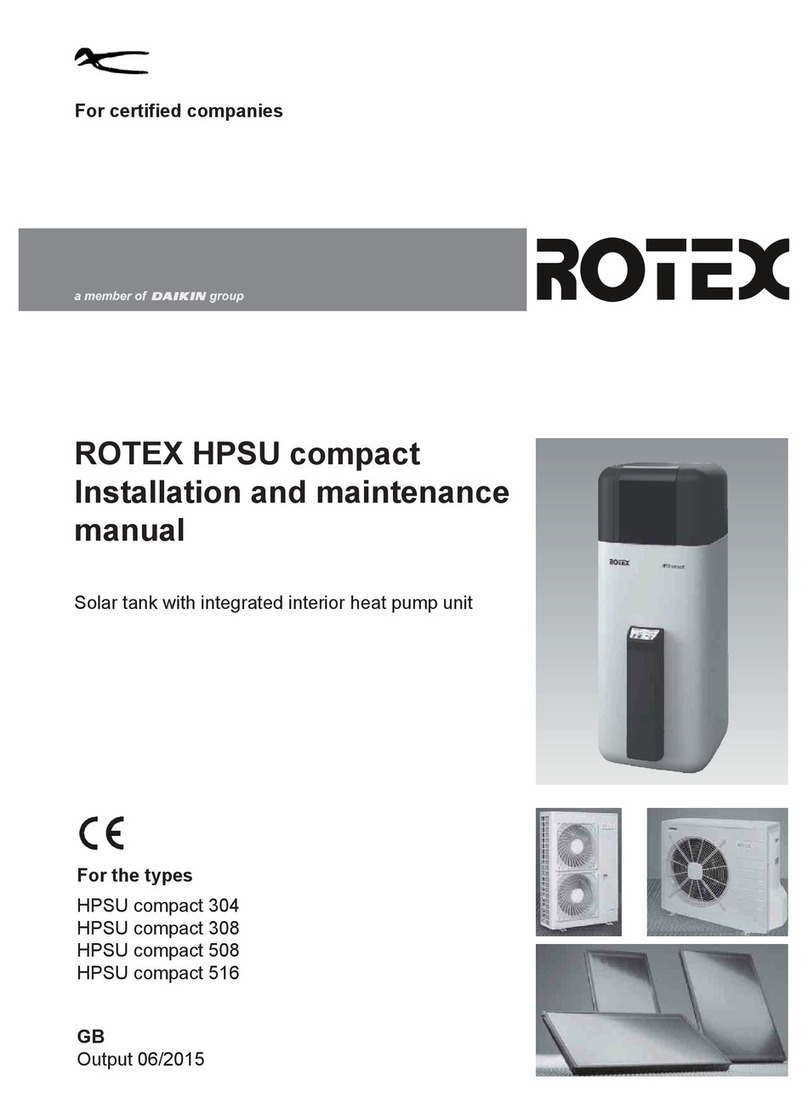
Rotex
Rotex HPSU compact 304 Installation and maintenance manual
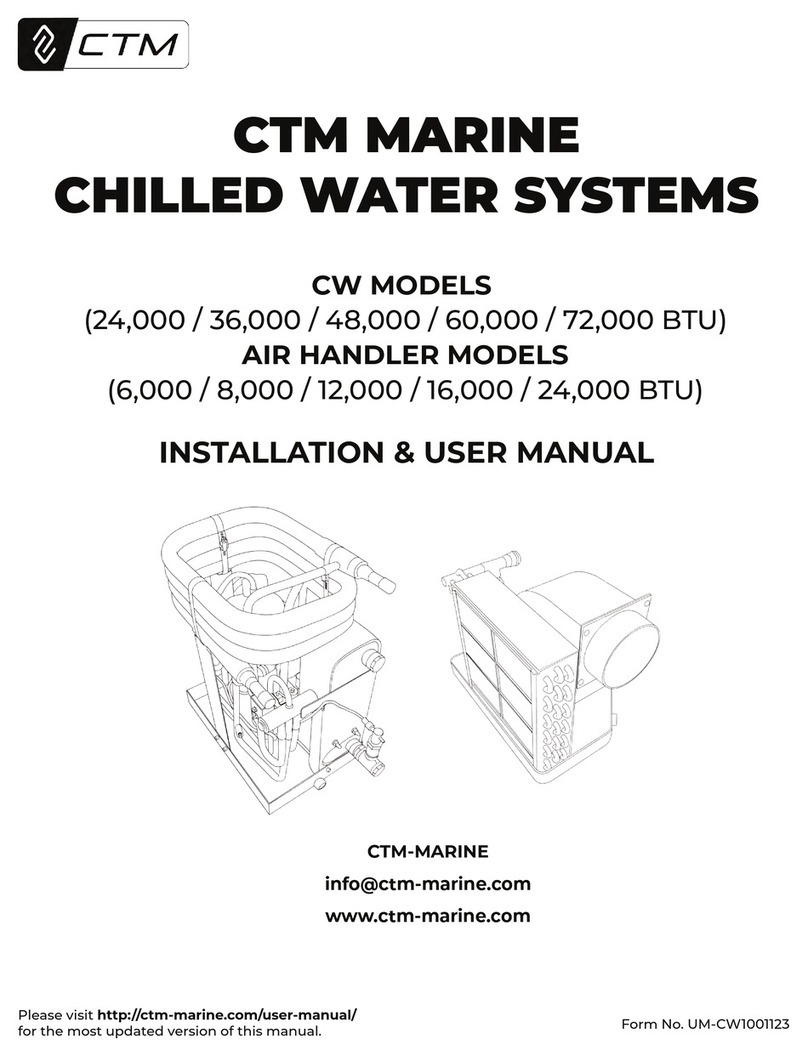
CTM
CTM CW-24H Installation & user manual
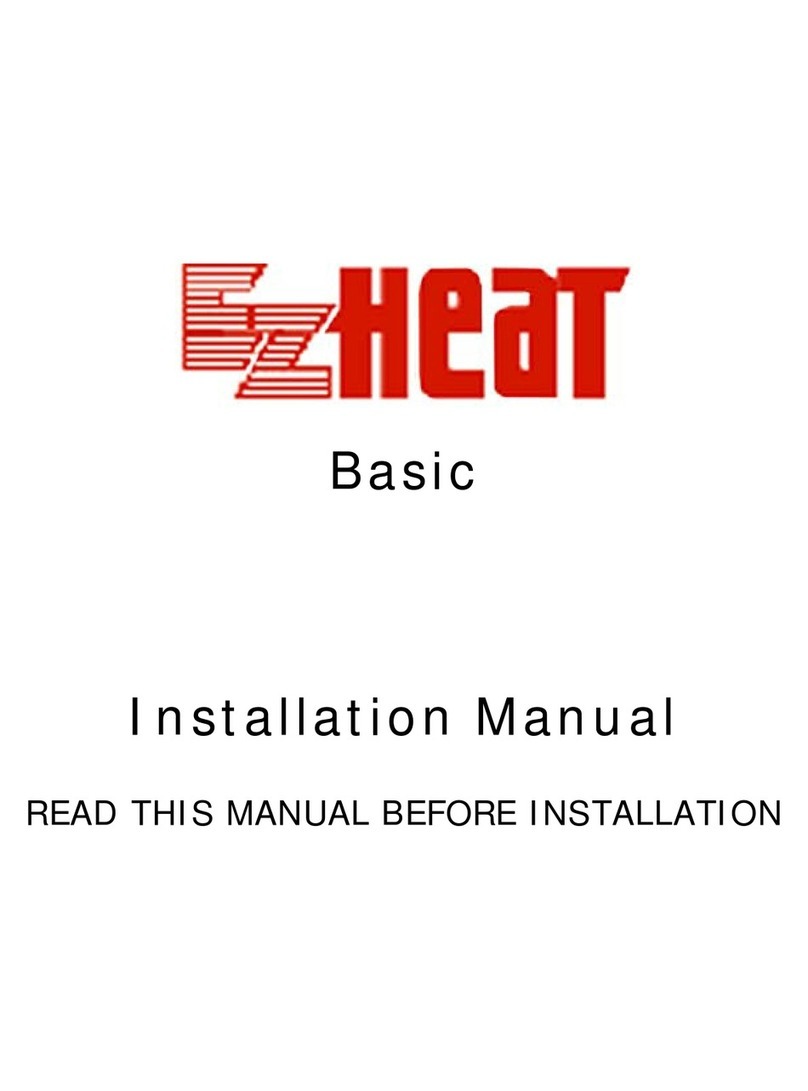
EZ Heat
EZ Heat Basic installation manual


